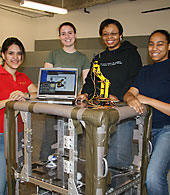Engineers
Play Catch in the Sky

Left to right: Sahara
Hernandez, Meghan Irving, Diana Larry, Elyse Steiner,
and their robotic arm |
They call themselves
Team Catch, but it’s actually
a robotic arm that will do the catching this week when four
engineering students conduct experiments in minimum gravity
aboard a NASA airplane.
The student team traveled
to Houston for ten days beginning March 19 to participate
in the Reduced Gravity Student Flight Opportunities Program
at NASA. The program invites students from about 50 American
educational institutions to fly on a KC-135 aircraft in
flight patterns designed to minimize gravity inside the plane.
The so-called Zero-G
program gives students the opportunity to conduct research
in a near-weightless setting. Students experience
simulated weightlessness for about 30 seconds during the
descent portion of each flight. Each outing will consist
of about 20 such patterns, called "parabolas."
Meghan Irving ’07, Sahara Hernandez ’07, Diana
Larry ’08, and Elyse Steiner ’07 will test their
robot’s abilities to track and catch a ball in microgravity.
The robot will use web cameras to establish a field of vision,
then will use information collected from the cameras’ tracking
system to estimate the trajectory of a thrown ball. As students
make adjustments, the robot will eventually be able to catch
the ball consistently, according to the students’ plan.
Before they get
to that point, though, they will spend a few days at NASA
preparing, assembling the robot’s
parts and undergoing testing for the flights.
“We will be going through a whole day of physical
and medical preparation to ensure that we understand what
our bodies will experience in microgravity,” explained
Hernandez before departing.
What their bodies will experience can be temporarily stressful.
The first parabola, as the flights are called, will likely
surpass the thrill of the wildest amusement park ride, but
by the tenth parabola, motion sickness will steal away the
thrill. Then, typically, the body gradually adjusts to the
sensation for the remaining arcs.
In addition to developing
their problem-solving skills, the students have gained computer
programming expertise, as well as technical writing practice
and experience using machinery to build their robot, says
Hernandez. When they return, the team will present their
findings at Smith and will submit a final report to the NASA
program. They also plan to participate in outreach programs,
such as presenting their project to local students, to help
educate potential younger engineers through their experience.
“We hope to get others as excited about the program
as our team, to be able to encourage more girls and females
to pursue a field in the sciences,” said Hernandez.
|























